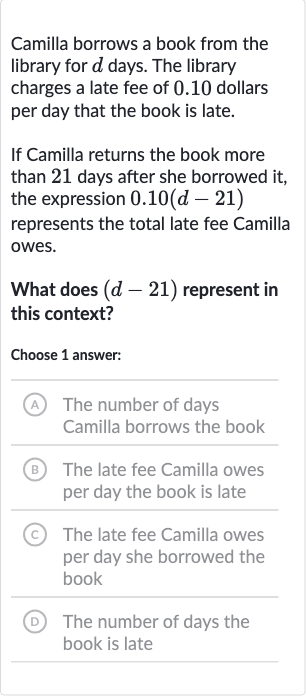AI tutor
Welcome to Bytelearn!
Let’s check out your problem:

Camilla borrows a book from the library for days. The library charges a late fee of . dollars per day that the book is late.If Camilla returns the book more than days after she borrowed it, the expression represents the total late fee Camilla owes.What does represent in this context?Choose answer:(A) The number of days Camilla borrows the book(B) The late fee Camilla owes per day the book is late(C) The late fee Camilla owes per day she borrowed the book(D) The number of days the book is late
Full solution
Q. Camilla borrows a book from the library for days. The library charges a late fee of . dollars per day that the book is late.If Camilla returns the book more than days after she borrowed it, the expression represents the total late fee Camilla owes.What does represent in this context?Choose answer:(A) The number of days Camilla borrows the book(B) The late fee Camilla owes per day the book is late(C) The late fee Camilla owes per day she borrowed the book(D) The number of days the book is late
- Understand Problem Context: Understand the context of the problem. Camilla borrows a book from the library and is charged a late fee of per day after the book is due. The book is due after days, and the expression for calculating the late fee is .
- Analyze Expression: Analyze the expression . The expression is used to calculate the total late fee. The represents the late fee per day, and represents the number of days the book is late.
- Determine Representation: Determine what represents.Since represents the total number of days Camilla has the book and is the number of days she can have it without a late fee, represents the number of days the book is late.
More problems from Interpret parts of quadratic expressions: word problems
QuestionGet tutor help
QuestionGet tutor help
QuestionGet tutor help
QuestionGet tutor help
QuestionGet tutor help
QuestionGet tutor help
QuestionGet tutor help
QuestionGet tutor help
